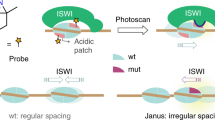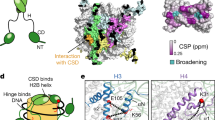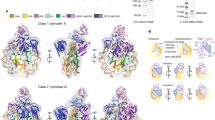Abstract
A hallmark of histone H3 lysine 9 (H3K9)-methylated heterochromatin, conserved from the fission yeast Schizosaccharomyces pombe to humans, is its ability to spread to adjacent genomic regions1,2,3,4,5,6. Central to heterochromatin spread is heterochromatin protein 1 (HP1), which recognizes H3K9-methylated chromatin, oligomerizes and forms a versatile platform that participates in diverse nuclear functions, ranging from gene silencing to chromosome segregation1,2,3,4,5,6. How HP1 proteins assemble on methylated nucleosomal templates and how the HP1–nucleosome complex achieves functional versatility remain poorly understood. Here we show that binding of the key S. pombe HP1 protein, Swi6, to methylated nucleosomes drives a switch from an auto-inhibited state to a spreading-competent state. In the auto-inhibited state, a histone-mimic sequence in one Swi6 monomer blocks methyl-mark recognition by the chromodomain of another monomer. Auto-inhibition is relieved by recognition of two template features, the H3K9 methyl mark and nucleosomal DNA. Cryo-electron-microscopy-based reconstruction of the Swi6–nucleosome complex provides the overall architecture of the spreading-competent state in which two unbound chromodomain sticky ends appear exposed. Disruption of the switch between the auto-inhibited and spreading-competent states disrupts heterochromatin assembly and gene silencing in vivo. These findings are reminiscent of other conditionally activated polymerization processes, such as actin nucleation, and open up a new class of regulatory mechanisms that operate on chromatin in vivo.
This is a preview of subscription content, access via your institution
Access options
Subscribe to this journal
Receive 51 print issues and online access
$199.00 per year
only $3.90 per issue
Buy this article
- Purchase on Springer Link
- Instant access to full article PDF
Prices may be subject to local taxes which are calculated during checkout




Similar content being viewed by others
References
Eissenberg, J. C. & Elgin, S. C. The HP1 protein family: getting a grip on chromatin. Curr. Opin. Genet. Dev. 10, 204–210 (2000)
Lachner, M., O’Carroll, D., Rea, S., Mechtler, K. & Jenuwein, T. Methylation of histone H3 lysine 9 creates a binding site for HP1 proteins. Nature 410, 116–120 (2001)
Nakayama, J., Rice, J. C., Strahl, B. D., Allis, C. D. & Grewal, S. I. Role of histone H3 lysine 9 methylation in epigenetic control of heterochromatin assembly. Science 292, 110–113 (2001)
Noma, K., Allis, C. D. & Grewal, S. I. Transitions in distinct histone H3 methylation patterns at the heterochromatin domain boundaries. Science 293, 1150–1155 (2001)
Grewal, S. I. S. & Jia, S. Heterochromatin revisited. Nature Rev. Genet. 8, 35–46 (2007)
Hall, I. M. et al. Establishment and maintenance of a heterochromatin domain. Science 297, 2232–2237 (2002)
Bannister, A. J. et al. Selective recognition of methylated lysine 9 on histone H3 by the HP1 chromo domain. Nature 410, 120–124 (2001)
Jacobs, S. A. & Khorasanizadeh, S. Structure of HP1 chromodomain bound to a lysine 9-methylated histone H3 tail. Science 295, 2080–2083 (2002)
Nielsen, P. R. et al. Structure of the HP1 chromodomain bound to histone H3 methylated at lysine 9. Nature 416, 103–107 (2002)
Yamada, T., Fukuda, R., Himeno, M. & Sugimoto, K. Functional domain structure of human heterochromatin protein HP1(Hsa): involvement of internal DNA-binding and C-terminal self-association domains in the formation of discrete dots in interphase nuclei. J. Biochem. 125, 832–837 (1999)
Brasher, S. V. et al. The structure of mouse HP1 suggests a unique mode of single peptide recognition by the shadow chromo domain dimer. EMBO J. 19, 1587–1597 (2000)
Cowieson, N. P., Partridge</url>, J. F., Allshire, R. C. & McLaughlin, P. J. Dimerisation of a chromo shadow domain and distinctions from the chromodomain as revealed by structural analysis. Curr. Biol. 10, 517–525 (2000)
Smothers, J. F. & Henikoff, S. The HP1 chromo shadow domain binds a consensus peptide pentamer. Curr. Biol. 10, 27–30 (2000)
Mendez, D. L. et al. The HP1a disordered C terminus and chromo shadow domain cooperate to select target peptide partners. Chembiochem 12, 1084–1096 (2011)
Zhao, T., Heyduk, T., Allis, C. D. & Eissenberg, J. C. Heterochromatin protein 1 binds to nucleosomes and DNA in vitro. J. Biol. Chem. 275, 28332–28338 (2000)
Keller, C. et al. HP1Swi6 mediates the recognition and destruction of heterochromatic RNA transcripts. Mol. Cell (2012)
Wang, G. et al. Conservation of heterochromatin protein 1 function. Mol. Cell. Biol. 20, 6970–6983 (2000)
Canzio, D. et al. Chromodomain-mediated oligomerization of HP1 suggests a nucleosome-bridging mechanism for heterochromatin assembly. Mol. Cell 41, 67–81 (2011)
Frigon, R. P. & Timasheff, S. Magnesium-induced self-association of calf brain tubulin. II. Thermodynamics. Biochemistry 14, 4567–4573 (1975)
LeRoy, G. et al. Heterochromatin protein 1 is extensively decorated with histone code-like post-translational modifications. Mol. Cell. Proteom. 8, 2432–2442 (2009)
Sampath, S. C. et al. Methylation of a histone mimic within the histone methyltransferase G9a regulates protein complex assembly. Mol. Cell 27, 596–608 (2007)
Ruan, J. et al. Structural basis of the chromodomain of Cbx3 bound to methylated peptides from histone h1 and G9a. PLoS ONE 7, e35376 (2012)
Rice, S. et al. A structural change in the kinesin motor protein that drives motility. Nature 402, 778–784 (1999)
Dawson, M. A. et al. JAK2 phosphorylates histone H3Y41 and excludes HP1α from chromatin. Nature 461, 819–822 (2009)
Lavigne, M. et al. Interaction of HP1 and Brg1/Brm with the globular domain of histone H3 is required for HP1-mediated repression. PLoS Genet. 5, e1000769 (2009)
Richart, A. N., Brunner, C. I. W., Stott, K., Murzina, N. V. & Thomas, J. O. Characterization of chromoshadow domain-mediated binding of heterochromatin protein 1α (HP1α) to histone H3. J. Biol. Chem. 287, 18730–18737 (2012)
Sadaie, M., Iida, T., Urano, T. & Nakayama, J.-I. A chromodomain protein, Chp1, is required for the establishment of heterochromatin in fission yeast. EMBO J. 23, 3825–3835 (2004)
Sadaie, M. et al. Balance between distinct HP1 family proteins controls heterochromatin assembly in fission yeast. Mol. Cell. Biol. 28, 6973–6988 (2008)
Mullins, R. D. How WASP-family proteins and the Arp2/3 complex convert intracellular signals into cytoskeletal structures. Curr. Opin. Cell Biol. 12, 91–96 (2000)
Huse, M. & Kuriyan, J. The conformational plasticity of protein kinases. Cell 109, 275–282 (2002)
Luger, K., Rechsteiner, T. J. & Richmond, T. J. Preparation of nucleosome core particle from recombinant histones. Methods Enzymol. 304, 3–19 (1999)
Simon, M. D. Installation of site-specific methylation into histones using methyl lysine analogs. Curr. Protocols Mol. Biol. Ch 21:Unit 21.18.1–10. (2010)
Vistica, J. et al. Sedimentation equilibrium analysis of protein interactions with global implicit mass conservation constraints and systematic noise decomposition. Anal. Biochem. 326, 234–256 (2004)
Purcell, T. J. et al. Nucleotide pocket thermodynamics measured by EPR reveal how energy partitioning relates myosin speed to efficiency. J. Mol. Biol. 407, 79–91 (2011)
Frank, J. et al. SPIDER and WEB: processing and visualization of images in 3D electron microscopy and related fields. J. Struct. Biol. 116, 190–199 (1996)
Li, X., Grigorieff, N. & Cheng, Y. GPU-enabled FREALIGN: accelerating single particle 3D reconstruction and refinement in Fourier space on graphics processors. J. Struct. Biol. 172, 407–412 (2010)
Mindell, J. A. & Grigorieff, N. Accurate determination of local defocus and specimen tilt in electron microscopy. J. Struct. Biol. 142, 334–347 (2003)
Ludtke, S. J., Baldwin, P. R. & Chiu, W. EMAN: semiautomated software for high-resolution single-particle reconstructions. J. Struct. Biol. 128, 82–97 (1999)
Pettersen, E. F. et al. UCSF Chimera–a visualization system for exploratory research and analysis. J. Comput. Chem. 25, 1605–1612 (2004)
Rougemaille, M., Shankar, S., Braun, S., Rowley, M. & Madhani, H. D. Ers1, a rapidly diverging protein essential for RNA interference-dependent heterochromatic silencing in Schizosaccharomyces pombe. J. Biol. Chem. 283, 25770–25773 (2008)
Acknowledgements
We thank J. Tretyakova for preparation of histone proteins and J. Leonard for sample preparation for cryo-electron microscopy of nucleosome alone. We thank W. Lim, M. Simon, K. Armache, J. Zalatan, L. Racki and members of the Narlikar laboratory for discussions. D.C. would like to thank I. Ortiz Torres and K. M. Kuchenbecker for scientific discussions and members of the Schuck laboratory for advice on AUC approaches. This work was supported by a grant from the Hillblom foundation to D.C., by grants from the American Cancer Society and Leukemia and Lymphoma Society to G.J.N., National Institutes of Health (NIH) grant R01GM071801 to H.D.M. and by a New Technology Award to Y.C. from the UCSF Program for Breakthrough Biomedical Research. P.S. was supported by the Intramural Research Program of the NIBIB, NIH. N.N. and E.P. were supported by the NIH grant AR053720.
Author information
Authors and Affiliations
Contributions
D.C. and G.J.N. identified, developed and addressed the core questions. D.C. performed the bulk of the experiments. P.S. trained D.C. in the use of AUC approaches and was instrumental in interpreting the AUC data. N.N. performed the EPR experiments. D.B.M. trained D.C. in strain construction and in the use of S. pombe assays. J.F.G. constructed some of the S. pombe strains and performed initial in vivo experiments. E.P., R.C., A.L. and D.C. deconvolved the EPR spectra. S.W. generated the cryo-electron-microscopy reconstruction of the nucleosome alone. M.L. generated the EM reconstructions of the Swi6–nucleosome complex and the two-dimensional reconstructions of the CFP–Swi6 and Swi6–CFP constructs. M.L., S.W. and Y.C. analysed the electron microscopy data. Y.C. oversaw all of the electron microscopy studies. H.D.M. oversaw the design and interpretation of the in vivo experiments. R.C. oversaw the EPR analysis and interpretation. D.C. and G.J.N. wrote the bulk of the manuscript with substantial intellectual contributions from R.C.
Corresponding author
Ethics declarations
Competing interests
The authors declare no competing financial interests.
Supplementary information
Supplementary Information
This file contains Supplementary Figures 1-9, Supplementary Tables 1-2, a Supplementary Discussion and additional references. (PDF 3547 kb)
Rights and permissions
About this article
Cite this article
Canzio, D., Liao, M., Naber, N. et al. A conformational switch in HP1 releases auto-inhibition to drive heterochromatin assembly. Nature 496, 377–381 (2013). https://doi.org/10.1038/nature12032
Received:
Accepted:
Published:
Issue Date:
DOI: https://doi.org/10.1038/nature12032
This article is cited by
-
Chemical-induced phase transition and global conformational reorganization of chromatin
Nature Communications (2023)
-
Dynamics of the HP1 Hinge Region with DNA Measured by Site-Directed Spin Labeling-EPR Spectroscopy
Applied Magnetic Resonance (2023)
-
The regional sequestration of heterochromatin structural proteins is critical to form and maintain silent chromatin
Epigenetics & Chromatin (2022)
-
Functions of HP1 proteins in transcriptional regulation
Epigenetics & Chromatin (2022)
-
HP1a-mediated heterochromatin formation promotes antimicrobial responses against Pseudomonas aeruginosa infection
BMC Biology (2022)
Comments
By submitting a comment you agree to abide by our Terms and Community Guidelines. If you find something abusive or that does not comply with our terms or guidelines please flag it as inappropriate.



